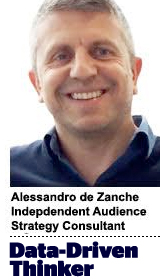 “Data-Driven Thinking” is written by members of the media community and contains fresh ideas on the digital revolution in media.
“Data-Driven Thinking” is written by members of the media community and contains fresh ideas on the digital revolution in media.
Today’s column is written by Alessandro De Zanche, an independent audience strategy consultant.
When I worked at Yahoo during the golden years, I met many extremely talented and knowledgeable people. In 2011, one of my colleagues became redundant in one of several rounds of layoffs. He was a strong ad tech support guy, with many years of core expertise in video technology, rich media and ad serving – the classic types of knowledge that make someone irreplaceable in a team.
Anybody who knew him would have bet it would have taken days, not even weeks, for him to find a new job. It took more than six months.
Why? Recruiters and companies obsessively and almost exclusively searched for people with programmatic experience, which he didn’t specifically have. With programmatic being relatively new, recruiters focused on candidates with two to three years of programmatic experience.
How long would it have taken for someone like my ex-colleague, with a decade of experience in the industry, to catch up with the programmatic ecosystem of seven years ago? How much added value could he have brought to the business and final product, first and foremost to the user experience?
How healthy is an industry that, by discarding the past, cannot fully understand the present and how it developed into its current form? How can an industry envision its future without knowing where it all started?
The programmatic frenzy of early 2010s led to many jumping on the bandwagon and forgetting the multifaceted aspects of digital advertising. A programmatic monoculture emerged as the industry’s focus shifted from a holistic, creative approach to a very narrow one.
The principles of advertising and marketing became secondary to scale and reach – an industrial quantity of cookies, IDs and data points. “More” became the obsession. Who cares about the user experience? Give me eyeballs!
Allow me to reinforce the point with another anecdote. I used to work for one of the biggest, if not the biggest, rich-media platforms back in 2004. The platform synced and connected the three components of an advertising campaign: the advertiser and its creative agency, the media agency and the publisher.
The creative agency would provide the creative assets, such as video files, images, functionalities to support users’ interaction with ads and downloadable assets, which were assembled and turned into a functioning and trackable multimedia interactive ad within the platform. It would then be associated with the media plan created by the agency and involve multiple publishers, which would use the platform to check and approve the creative and generate the tags to set the campaigns live.
The bigger the volume of ad impressions generated by a campaign, the more revenue for us, the rich-media company in the middle. Despite our direct financial interest in having every campaign active and serving the highest possible amount of impressions, at no time would we, for any reason, allow our clients to run an ad that didn’t follow best practices. A best practices checklist functionality would need to be ticked through or the campaign couldn’t technically go live.
You call me nostalgic? Fast-forward 12 years and the IAB, trying to stop the huge surge in ad blocking caused by a user backlash against digital advertising, released the LEAN principles’ guidelines. Most of it is little more than the best practices we used to enforce 12 years ago, 90% of which was just common sense applied to user experience.
What happened? The rise of the programmatic monoculture, the shift from quality to quantity and an almost ideological obsession with reach and automation.
Inevitably that had an effect on the employee profile and skills that companies looked for, flattening the diversity of experiences and points of view and giving almost exclusive priority to programmatic experience, which in turn has created some of the challenges the industry is trying to address today.
We are slowly improving, although it is still a mainstream tendency to pigeonhole people’s skills and backgrounds instead of valuing the richness of complementary experiences versus monothematic professional trajectories, which often miss the bigger picture or act on theory rather than real-life practice.
If we look at the average age of people working in the digital advertising ecosystem, and especially in programmatic, we will find a puzzling countertrend compared to other creative industries. Would the movie industry sideline Francis Ford Coppola for being too traditional if he didn’t have 3-D shooting experience and hire a 3-D expert instead?
The richest future comes from an understanding of the past and the evolution of our industry, as well as a balanced and objective analysis of the present, with all its positives and negatives.
A monocultural ecosystem driven by shallow expertise is destined to fail. Programmatic must embrace the prismatic nature of advertising and marketing if it wants to remain at the forefront. It requires harmony and a synthesis of needs, strengths and weaknesses, which come with experience and diversity.
Follow Alessandro De Zanche (@fastbreakdgtl) and AdExchanger (@adexchanger) on Twitter.
This post was syndicated from Ad Exchanger.


More Stories
Daily Wire Welcomes Perplexity to Advertise on The Ben Shapiro Show
Here’s the Roundup for the Week Ending March 7
Aflac’s Dan Amos Reveals How He’s Successfully Held Onto the CEO’s Job for 35 Years